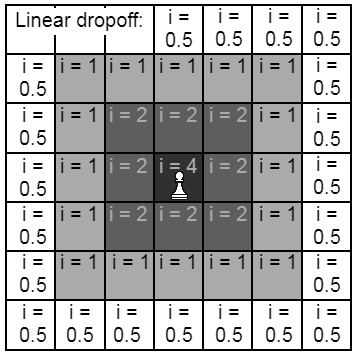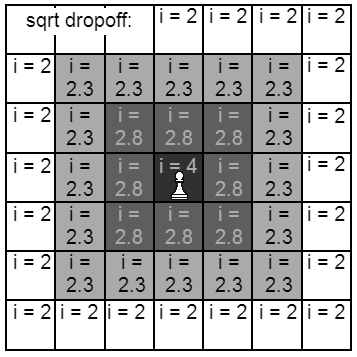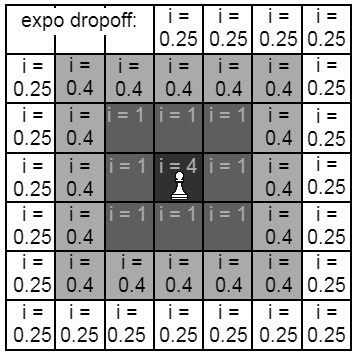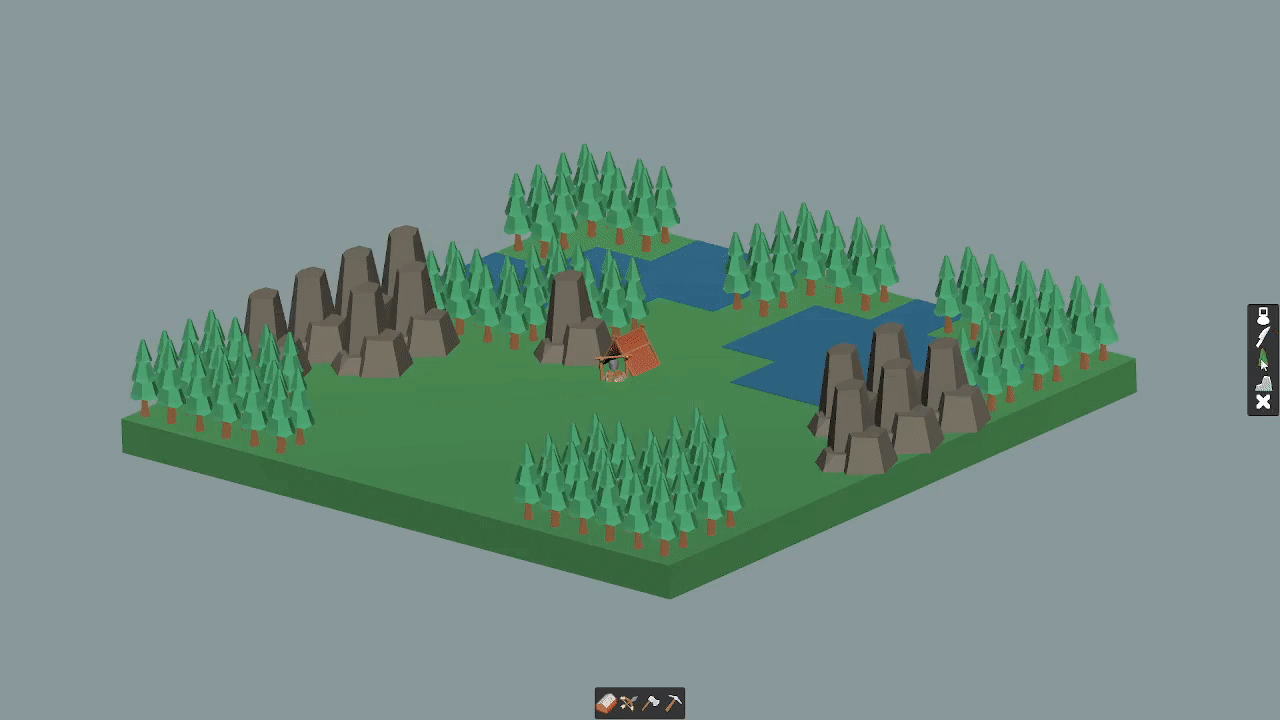Introduction: What are Influence Maps?
How fun would a strategy game be if the AI sat there or just acted randomly? Probably not that fun. But I would argue that it’s more fun than an AI knowing absolutely everything and acting like a robot. The average AI should be somewhere between being a total rookie and a grandmaster. Part of the answer to making a “human-like” AI is the use of Tactical Analysis (AKA influence maps). The simplest example of an influence map I can conjure up can be seen on the right
In this case, a unit is on the grid (where the influence is highest). From there, its influence decays as it spreads into the neighboring tiles. If more units were present, their influence could combine (if they are friendly) or combat (if they are enemies). What this allows is a representation of the state of a graph/world/combat in a numerical way that an AI can analyze.
While in my initial example I used units, influence maps are not limited to just military units. Alex Champandard’s article on gamedev.net talks about three broad categories that influence maps could fall into: situation summary maps, historical statistics maps, and future prediction maps.
For this project, my tech demo focused on Situation Summary maps
Situation Summary:
“Who is in control of what area? Where are the borders between the territories? How much enemy presence is there in each area?” (Champandard). Can also be used to find where the valuable places are.
Historical Statistics:
“Influence maps can also remember what happened for a certain period of time. Was this area being assaulted? How well did my previous attack go?” (Champandard). By storing and comparing influence maps (e.g. to see where the most territory is being lost/gained) historical data can be obtained and acted on.
Future Prediction:
“Using the map of the terrain, you can figure out where an enemy would go and how his influence would extend in the future” (Champandard).
An example map made in my tech demo. It contains mountains, trees, lakes, fields, and an outpost.
The influence map, specifically for logging, overlaid onto the example map. Orange is where the most logs are. Uses a set radius and sqrt dropoff to calculate influence.
Switching between different influence maps with influence determined by the radius method
Convolution method (from Champandard's article)
Genres and Platforms
All my sources listed the RTS genre as the starting place of influence maps which makes sense. Influence maps allow for dynamic reevaluation of a game world which is important when trying to do strategy in real time. There are a few cases where influence mapping might not be required. If the map you are implementing is really simple, you don’t really need to map it out (Champandad). For example, if everything takes place on an open plain, just use distance based calculations. Any game where the AI does not have to make complicated decisions probably does not require any kind of influence mapping (e.g. platformer where enemies follow a path or behavior that can be implemented using a behavior tree).
One interesting application I found is a paper about using influence mapping during pathfinding. What it found is that, “Influence map-based pathfinding opens a new possibility in pathfinding. Paths become aware of their surroundings, events or game specific characteristics (e.g., sound, faction location, line of sight, etc.). Game agents are therefore better informed at path planning, and changing the way they navigate through their environments.” (Adaixo, 44). A lot of resources focused on units but as shown in my tech demo, it can also be used for decision making on a higher level (an AI figuring out where to expand). In an FPS, the enemy AI might be able to use influence mapping to make more calculated decisions against a player.
As stated before, the base efficiency of influence maps is pretty bad although it can be improved. For split-second decisions, AI should probably delegate to something faster like a behavior tree. Because most parts of the algorithms can be interrupted, I think it could be adapted to a tile-based or strategy mobile game even though mobile devices do not have fast hardware. Influence maps overall have a lot of flexibility and potential and so should be considered a lot of the time when implementing an AI.
Works Cited:
Champandard, Alex J. “The Core Mechanics of Influence Mapping.” GameDev.net, GameDev.net, 8 June 2011, https://www.gamedev.net/tutorials/programming/artificial-intelligence/the-core-mechanics-of-influence-mapping-r2799/.
This really was a great resource. The article contains a video going through it. Additionally, there is a talk done at GDC by him covering the same topic.
Adaixo, Michael. Influence Map-Based Pathfinding Algorithms in Video Games. 2014. https://ubibliorum.ubi.pt/bitstream/10400.6/5517/1/3443_6881.pdf
Millington, Ian. AI for Games. CRC Press, 2022.







